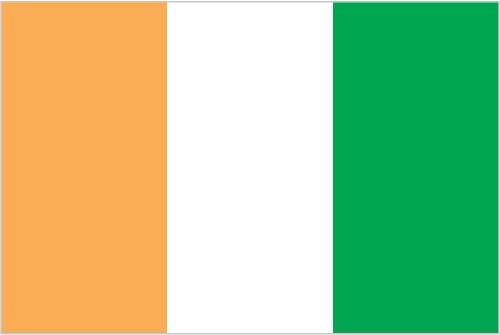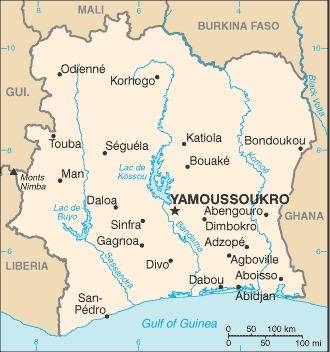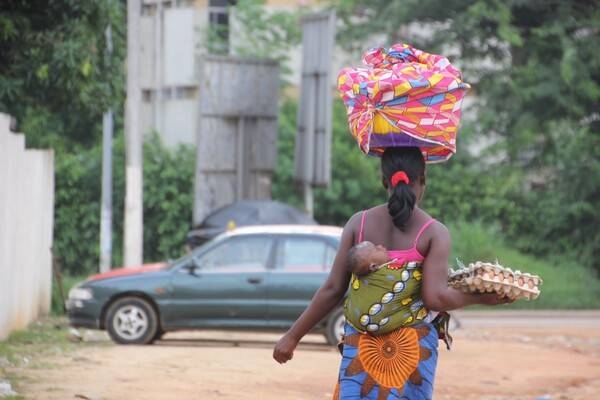189 Cote D’Ivoire

Three equal vertical bands of orange (hoist side), white, and green. Orange symbolizes the land (savannah) of the north and fertility, white stands for peace and unity, green represents the forests of the south and the hope for a bright future.
Flag courtesy of the CIA World Factbook

Map courtesy of the CIA World Factbook

A woman carrying eggs and a baby. Côte d’Ivoire is a juxtaposition of urban and rural conditions. Its cities, particularly Abidjan, are full of modern office buildings, condominiums, European-style boutiques, and trendy restaurants. They stand in sharp contrast to the country’s many villages – accessed mainly by dirt roads – whose architecture is comprised of huts and simple abodes. While the cities are described as crowded urban enclaves with traffic and a dichotomy of rich and poor residents, the villages are filled with farmers tending their fields, native dress, homemade pottery, and traditional tribal rituals.
Photo courtesy of the CIA World Factbook
Government
According to Britannica, Côte d’Ivoire was proclaimed an independent republic on August 7, 1960. The 1960 constitution was suspended following the December 1999 military coup, and a new constitution was approved in 2000. Another new constitution was approved in 2016 and amended in 2020, under which executive power is vested in the president, who is directly elected, serves a five-year term, and, beginning in 2020, can only be reelected once. The president, who serves as the head of state, is assisted by a vice president, who is chosen by the elected president and approved by parliament. The president is also assisted by the prime minister, who serves as the head of government. The president appoints the prime minister and, with the prime minister’s recommendations, the Council of Ministers. In addition, there are two other advisory bodies: the Economic, Social, Environmental and Cultural Council and the Constitutional Council. Legislative power is vested in a bicameral parliament, consisting of the National Assembly and the Senate. The 255 members of the National Assembly are directly elected for five-year terms. The Senate, which was provided for under the 2016 constitution but was not created until 2018, has 99 members, of which 66 are indirectly elected by local and regional councils and 33 are appointed by the president. Senators serve a five-year term.
Yamoussoukro was officially named the new national capital in 1983, but austerity measures, civil conflict, and other factors have slowed the transfer of government functions, and Abidjan remains the de facto capital.
For administrative purposes, Côte d’Ivoire is divided into 2 autonomous districts (Abidjan and Yamoussoukro) and 12 districts, which are further divided into régions and then départements. There are also smaller administrative units of sous-préfectures, communes, and villages, each with an elected council.
Côte d’Ivoire has an independent judiciary. The three highest bodies are the Court of Cassation, which deals with criminal and civil matters; the Council of State, which handles administrative disputes; and the Court of Auditors, which oversees matters pertaining to public finances and accounts. There are also subordinate Courts of Appeal and Courts of First Instance. The Superior Council of Magistracy is the body that oversees matters pertaining to the employment and disciplinary matters of judges.
The High Court of Justice is a court of exceptional jurisdiction that judges the president, vice president, and other members of the government. The Constitutional Council is concerned with electoral issues and the constitutionality of laws.
National Civil Aviation Authority (ANAC)
The National Civil Aviation Authority (ANAC) is headed by a Director General appointed by decree issued by the Council of Ministers. It has a Supervisory Board whose mission is to supervise the management of the Director General, the services or departments and the activities of the National Civil Aviation Authority (ANAC). It meets at least twice a year and as often as ANAC’s interests require. The Supervisory Board is made up of eight (8) members. The current Supervisory Board was set up by decree no. 2014-601 of October 16, 2014.
Airspace
SkyVector – Google Maps – ADS-B Exchange
ICAO countries publish an Aeronautical Information Publication (AIP). This document is divided into three parts: General (GEN), En Route (ENR) and Aerodromes (AD). ENR 1.4 details the types of airspace classes they chose to adopt from classes A through G.
Drone Regulations
Authorization of a drone operator for aerial work
Remotely piloted aircraft (drone)
Advanced Air Mobility (AAM) Regulations & Policies
None found by the author.
However, should you, the reader, happen to stumble across something to the contrary, please email the author at FISHE5CA@erau.edu and you may be mentioned in the ACKNOWLEDGEMENTS section of this book by way of thanks for contributing to this free eBook!
Advanced Air Mobility (AAM) News
None found by the author.
However, should you, the reader, happen to stumble across something to the contrary, please email the author at FISHE5CA@erau.edu and you may be mentioned in the ACKNOWLEDGEMENTS section of this book by way of thanks for contributing to this free eBook!
Short Essay Questions
Scenario-Based Question
You have been hired by a Drone Startup Company. Your boss has immediately assigned this job to you.
They need you to prepare a one-page memo detailing the legalities of using a drone to film in Abidjan, pictured above.
They need you to mention any national laws and local ordinances.
They specifically want to know what airspace (insert pictures) you will be operating in and whether or not you need an airspace authorization.
Does it matter whether or not you are a citizen of the country?
Lastly, there is a bonus for you if, as you scroll through this chapter, you find any typos or broken links!
Short Essay Questions
- What are the drone categories?
- How is registration addressed?
- How is remote ID addressed?
- What are the model aircraft rules?
- What are the commercial drone rules?
- Are there waivers or exemptions to the rules? If so, for what?
- Would you share a link to an interactive airspace map?
- How is BVLOS addressed?
- How can you fly drones at night?
- How can you fly drones over people?
- Where do you find drone NOTAMs?
- What are the rules for drone maintenance?
- What are the rules for an SMS program?
- What are some unique rules not mentioned above?
- What are the C-UAS rules?
- What are the AAM rules?

